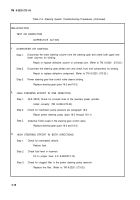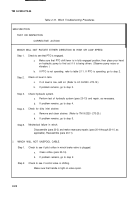TM-9-2320-273-34 - Page 44 of 801
TM 9-2320-273-34
Do not allow drycleaning solvents to come
in contact with seals or flexible hoses.
These cleaners cause leather, rubber, and
synthetic materials to dry out, rot, and
lose pliability.
d. Oil Seals and Flexible Hoses.
Clean seals and flexible hoses with soap and water.
e. Ball Bearings.
(1)
Bearings require special cleaning. After removing surface oil and gum deposits, place
bearings in hot oil (140°F) to loosen congealed oil and grease. Wipe bearings dry; do not use compressed
air. After cleaning, coat bearings with a light film of oil, and wrap in paper until parts are inspected
and assembled.
(2)
Refer to TM 9-214 for information on care and maintenance of bearings.
2-7. Inspection.
Procedures for inspection will be the same for most parts and components which
comprise the vehicle components. To avoid repetition of instructions, the general procedures for in-
spection are detailed in
a
through
f, below.
Any inspection procedures which are peculiar to a specific
part or component are covered in the section or paragraph relating to that item.
a. Castings.
(1)
Inspect
all ferrous and nonferrous castings for cracks using a magnifying glass and strong
light. Particularly check the areas adjacent to studs, pipe plugs, threaded inserts, and in sharp corners and
fillets.
(2)
Inspect machined surfaces of castings for nicks, burrs, and raised metal. Mark damaged
areas for repair.
(3)
Check all mating flanges on housings and supports for warpage with a straightedge, or on a
surface plate. Inspect mating flanges for discoloration which may indicate persistent oil leakage.
(4)
Inspect all pipe plug and capscrew-tapped openings for damaged or stripped threads.
(5)
Check all castings for conformance to applicable repair standards.
b. Ball and Roller Bearings.
Refer to TM 9-214 for inspection of bearings. Check all bearings for
conformance to applicable repair standards.
c. Studs.
Inspect all studs for stripped or damaged threads, bent or loose conditions, and evidence
of stretching.
d.
Gears.
(1)
Inspect all gears for cracks, using a magnifying glass and a strong light.
(2)
Inspect all gear teeth for wear, sharp fins,
burrs, and
galled or pitted surfaces.
2-28
CAUTION
Back to Top




















